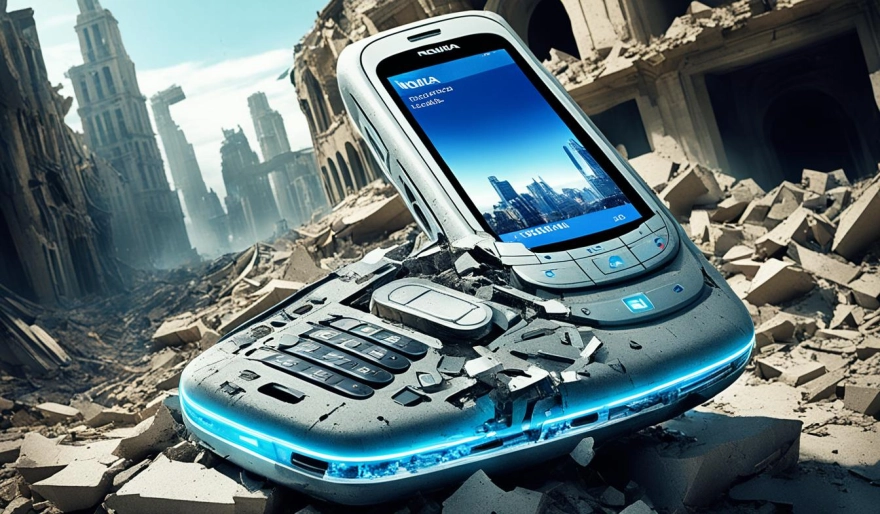Nokia: The Story of the Once-Legendary Phone Maker
45 min read Nokia: The Story of the Once-Legendary Phone Maker - written by Hamza Bose, Senior Content Marketer July 27, 2024 21:35
Nokia: The Story of the Once-Legendary Phone Maker
Nokia is a Finnish giant in the worlds of telecom and electronics. It started in 1865 as a paper mill by Fredrik Idestam. Over time, it moved into rubber, cables, and then mobile phones. Nokia has always found new ways to succeed, even after struggling.
The early foundation of Nokia's success dates back to 1979. Its subsidiary, Mobira Oy, kickstarted the world's first automated cellular network, NMT. This allowed people to make calls internationally. Then, in 1982, Nokia made the DX200, a digital switchboard used worldwide until 2013.
In the early phases of mobile tech, Nokia also teamed up with Tandy to sell phones in the US. Even when hit by the collapse of the Soviet Union and the European recession, Nokia thrived. This time marked a true test of Nokia’s strength. It showed the world its power to evolve and stay ahead.
Key Takeaways
- Nokia began in 1865 as a small paper mill and grew into a leader in mobile tech.
- In 1979, Nokia made the first worldwide automated cellular network, NMT, and in 1982, the DX200 switchboard. These were groundbreaking for the industry.
- Nokia faced tough times like the Soviet Union's end and a European recession but emerged stronger. It showed its skill in adapting to change.
- Nokia has a vibrant history in mobile technology, shaping the standards we use today.
- Even with smartphone challenges, Nokia stays relevant by focusing on network tech and telecom equipment.
Origins: From Paper Mill to Industrial Conglomerate
In 1865, Nokia took its first steps when Fredrik Idestam started a simple paper mill operation in Finland. It was named after a nearby town, Nokia, in 1871, starting a journey to worldwide success.
Nokia's Humble Beginnings in 1865
Nokia's story begins long before today's tech giants like Intel and Microsoft, founded in the late 1900s. It started as a forestry business and later grew into rubber and cable making. In 1967, these activities were part of Nokia Corporation.
Expansion into Rubber, Cables, and Electrical Products
Over time, Nokia grew beyond its paper origins into rubber goods and cables. As it diversified, it began producing electrical products. Soon, its offerings included generators and equipment for nuclear power plants.
Despite hard times during the Second World War, Nokia kept growing. It directed its exports both west and to the Soviet Union in the 1950s.
Looking ahead, CEO Bjorn Westerlund warned about depending too much on the Soviet Union. This advice was vital. It led Nokia to focus on electronics and telecom, later becoming a key player in the mobile phone market.
"Nokia's legacy traces back to its origins as a small forestry enterprise in the late 19th century."
In the late 1980s, key agreements with the United States sparked Nokia's growth in new areas. Between 1945 and 1980, Nokia merged different electronics and communication units, strengthening its position.
The 1981 acquisition of Televa Oy was foundational for Nokia's move into electronics. This event laid the groundwork for Nokia's significant journey to leadership in mobile technology.
Pioneering Mobile Telecommunications
In the late 1970s, Nokia jumped into the world of mobile communications. They started with Mobira Oy, a partnership with Salora, a Finnish TV brand. This move was the beginning of Nokia's adventure in this fast-growing field.
In 1981, they brought the Nordic Mobile Telephone (NMT) service to life. It was the first global automated cellular network system. Thanks to NMT, people could use their phones outside their own countries for the first time. This was a huge step. It laid the foundation for 1G wireless technology. This, in turn, led to the giant leap forward in mobile communication we've seen over the years.
Early Mobile Phone Innovations
Nokia didn’t stop there. They soon introduced early mobile phones like the big Mobira Senator car phone and the smaller Mobira Talkman. These were Nokia's first steps towards the Mobira Cityman, a truly handheld model.
In 1998, the Nokia 6100 series hit the shelves, selling over 41 million units. The sales were so good that Nokia's profits flew up by 75%. This was a turning point for Nokia in the mobile phone market.
Then came the super famous Nokia 3210, selling about 160 million units. These early Nokia phones changed the game and helped them become a top brand in mobile phones worldwide. Nokia has played a major part in growing the mobile telecommunications sector.
"The first handheld mobile phone, the DynaTAC, weighed over a kilogram and took more than ten hours to charge for only 30 minutes of battery life."
From the big Mobira Senator to the compact Mobira Cityman, Nokia was leading the field. These early models paved the way for Nokia's commanding position in mobile technology. The Nokia 6100 series and 3210 model showed Nokia's innovation and influence in the mobile market.
Rise to Dominance in the Mobile Phone Market
In the 1980s and 1990s, Nokia became a top name in mobile phones. It introduced the famous Mobira Cityman and invested early in cell network tech. This helped Nokia lead the market quickly, becoming a well-known choice for mobiles.
By the early 2000s, Nokia was the world's biggest phone maker. People loved its cool designs, great features, and solid performance. Nokia once owned about 40% of the market. In 2008, it hit a record by selling 472 million phones, getting a 38.6% share.
Nokia gained the top spot by listening to what people wanted. It consistently delivered new and high-quality products. Thanks to its focus on research, Nokia always stayed ahead, offering exciting features and designs worldwide.
Back then, Nokia stood for trusty and easy-to-use mobiles. Its classics like the Nokia 3310 are still remembered today. They helped establish Nokia as an industry leader.
| Year | Market Share | Units Sold (million) |
|---|---|---|
| 2008 | 38.6% | 472 |
| 2018 | 19.0% (Samsung) | 295 (Samsung) |
| 2018 | 13.4% (Apple) | 209 (Apple) |
Being the top brand wasn't easy, but Nokia did it by always innovating. As the market changed, though, Nokia's share fell. Still, it left a lasting legacy of groundbreaking hardware innovation.
Nokia's Transition to Smartphones
As touchscreens became popular, Nokia faced a big challenge. It needed to change its products and apps. Nokia was slow to switch from its Symbian system to iOS and Android. This delay hurt its place in the market.
Nokia joined with Microsoft in 2011. They decided to use the Windows Phone system. But this plan didn't attract many users. The Windows Phone struggled against iOS and Android.
Challenges in Adapting to Touchscreen Technology
Nokia was known for making phones with physical keyboards. These were trusted by many. Yet, when the market changed to touchscreens, Nokia fell behind. It struggled to catch up, especially against the iPhone and Android phones.
The late response to touchscreen tech was a big problem for Nokia. This mistake cost them a lot in the competitive smartphone world.
Partnership with Microsoft and the Windows Phone Platform
To catch up, Nokia joined forces with Microsoft in 2011. They aimed to use the Windows Phone for their devices. Their hope was to offer a strong option next to Android and iOS.
But, Nokia couldn’t attract enough users with the Windows Phone. This dwindling of their market share showed that the plan wasn't successful. The Microsoft partnership didn't work well. They struggled to get enough people and apps to the Windows Phone system.
"Nokia's transition to smartphones was a challenging period, as the company struggled to adapt to the rapidly changing mobile landscape. The partnership with Microsoft was a bold move, but it ultimately failed to pay off as the Windows Phone platform failed to gain significant market share."
Decline and Restructuring
Nokia lost its top spot in mobile phones as new tech came out quickly. Touchscreen smartphones from Apple and Google became very popular. This was tough for Nokia. By 2015, Nokia's share of the market went from 40% to just 1%. This was a big drop from its great past.
Sale of Mobile Phone Division to Microsoft
In 2013, Nokia sold its mobile phone part to Microsoft for $7.2 billion. This sale meant the end of great phones from Nokia. The company turned to building networks, telecom gear, and licensing tech. As touchscreen phones became popular, Nokia had a hard time keeping up.
This change was very important for Nokia's future. They needed to change to keep up with the market. Nokia didn't follow advice to focus more on the internet in their phones. Because of this, they couldn't compete well with Apple and Google.
| Company | Restructuring Timeline | Key Challenges |
|---|---|---|
| Nokia | Founded in 1865, Nokia started making phones in the 1970s and became a big name in early 2000s. But, they missed out on touchscreen phones and had to sell their mobile part to Microsoft in 2014. | They didn't move fast enough to internet smart devices, choosing their old style. They didn't keep up with Apple and Google's success. |
| Kodak | Kodak has struggled since 15 years ago trying to fit in with digital photos. | They made the first digital camera in 1975 but didn't focus on it until 1993. They forgot about their customers and focused on just the product. |
| Xerox | Xerox, a leader in copying, now plays a small part in managing documents. | They lost their top spot in copying by not changing with the times. |
| AT&T | AT&T changed from wired to wireless phones. | They had to change their services to keep up with new technology. |
Nokia's story drew a lot of interest in Finland, with some comparing it to big events like 9/11. The book "Operaatio Elop," out in 2014, talks about how CEO Stephen Elop's choices hurt Nokia.
Nokia's Current Business and Focus
After selling its mobile phone part, Nokia now focuses on network infrastructure and telecom equipment. It's a big name in crafting and setting up 4G and 5G networks. In 2023, the company made €22.26 billion and €1.688 billion as operating income. Its net income was €679 million that year. Nokia had assets worth €39.86 billion with equity at €20.63 billion in 2023. It had 86,689 employees globally in 2023.
Network Infrastructure and Telecom Equipment
Nokia mainly focuses on top-notch network infrastructure and telecom equipment. It works closely with global telecommunication companies. Its in-depth knowledge of 4G and 5G technologies makes it a top choice for network operators wanting to improve their networks. Nokia also leads in cloud computing, IoT, and automating networks. These areas help its clients stay competitive in the quickly changing telecom market.
Licensing and Intellectual Property
Licensing and intellectual property are key money makers for Nokia now. It owns a huge number of patents and tech licenses. Nokia licenses these to various tech firms, like smartphone makers and equipment providers. This part of the business helps Nokia bring in consistent money. Plus, it lets Nokia make good use of its R&D investments.
The Nokia brand is still strong with customers. But, Nokia is more focused on networking solutions now. It aims to make money from its tech investments, rather than focus on consumer electronics. This change in strategy has been beneficial for Nokia. It helped overcome the struggles from its mobile phone business days. Now, it aims for lasting success in the telco world.
"At the height of their success, Nokia was responsible for 20% of all exports from Finland and contributed 23% of all corporate taxes in the country."
Nokia: The Story of the Once-Legendary Phone Maker
The Nokia brand has been known for amazing mobile devices and a rich history in phones. It started in 1865 as a paper mill. It quickly became a leader in phones worldwide. Its journey tells a story of change, growth, and lasting influence.
In 2007, Nokia held over 50% of the global phone market. Its phones were loved for their unique designs and quality. The Lumia series, for example, was famous for its great hardware and cameras.
But, as smartphones became popular, Nokia faced new challenges. It couldn't match the appeal of touchscreens and iOS or Android. In 2013, Microsoft bought Nokia's mobile division, changing its path.
Yet, the Nokia brand has made a big comeback lately. A team of its former leaders started HMD Global to bring back the beloved brand. This led to new phones that people have liked. They offer a good choice in the phone market.
Now, Nokia is important in making mobile networks and phone tech. It's also doing well in simple feature phones, especially in poorer countries. The brand shows that staying resilient, innovative, and focused on good design is key. It still leaves a mark in the mobile world, loved by many.
"The Nokia 1020 is cited as the bar for cropped zoom photography on a phone."
Nokia's changing story is a lesson in staying relevant over time. It's about embracing new tech, innovating, and sticking to quality. HMD Global has proved that even great companies can come back strong. They've won people's hearts again.
| Nokia Milestones | Key Facts |
|---|---|
| The Nokia 3310 |
|
| Nokia's Early Mobile Phones |
|
| Nokia's Global Footprint |
|
The Nokia story inspires with its ups and downs. It's still shaping the mobile world today. As it moves forward in tech, keeping up its traditions is important. This will decide how it continues to impact the world.
The Nokia Brand Revival
In 2016, HMD Global started with the sole rights to make and sell Nokia phones. This led to a comeback of Nokia smartphones, using the brand's well-known name. So far, these phones haven't become as popular as older Nokia models. But, this move has kept Nokia in the market.
HMD Global and the Relaunch of Nokia Smartphones
HMD Global got Nokia's brand and tech in 2016 to bring the great phone maker back. They wanted to bring back Nokia's reputation for making dependable and tough phones.
Since then, HMD Global has released many new Nokia phones like the Nokia 6 and 8. They've also brought back old classics, such as the Nokia 3310 and Nokia 5310 XpressMusic.
The new Nokia phones haven't done as well as the famous Nokia 3310 yet, which sold 130 million units. Despite this, Nokia has stayed in the tight race of smartphone competition.
HMD Global's main plan is to make long-lasting, affordable Nokia phones that both old and new fans like. They're also spending a lot of money, up to $500 million in 3 years, to promote the brand and new phones.
The nokia brand revival journey goes on, with HMD Global working hard to win back the smartphone market. If they can create new and exciting Nokia phones for everyone, they could succeed.
Nokia's Impact on the Mobile Industry
Nokia has been a leading force in mobile tech, leaving a big mark. Their innovations shaped how wireless communication evolved. They set the stage for the wide use of cell phones and networks. While Nokia is not as active in making consumer phones, its legacy still guides the tech world.
Contributions to Wireless Technology Standards
Nokia was key in making global wireless standards like NMT and GSM. This helped mobile networks work together smoothly, making cell phone use global. Their efforts helped make cell tech widely available.
Their push for better wireless tech has deeply influenced the industry. Nokia's creative and technical leaps laid the groundwork for the devices and networks we depend on. Despite pulling back from making phones, Nokia's impact is strong in the telecom world.
"Nokia's contributions to the development of global wireless technology standards, such as NMT and GSM, have been instrumental in the industry's growth."
Lessons from Nokia's Journey
Nokia's journey from an industrial giant to a mobile phone leader shows the value of adapting in a changing market. The company struggled when touchscreen smartphones became popular with the arrival of iOS and Android. This shows the need for businesses to react quickly to new technology.
Nokia's success came from its focus on innovation and R&D, leading in wireless tech and mobile advancements. But, Apple's iPhone in 2007 began Nokia's market share drop, underlining the need for constant investment in research to stay competitive.
Adapting to Changing Market Dynamics
In 2005, Nokia held a 35% share in mobile phones and rose to 48% in smartphones in 2006. But, it couldn't keep up with the shift to touchscreens and new operating systems. So, its downfall eventually came.
Being able to adjust to new market trends is crucial for any business. Kodak and Thomas Cook went bankrupt by not adapting to digital photography and online agencies. Nokia's fall also highlights the importance of staying flexible.
Importance of Innovation and R&D
Nokia was a leader in 2005 with its Symbian system on 7 out of 10 smartphones. But, it couldn't follow the fast industry changes. This led to its decline.
Investing in research and development is essential for staying ahead in business. Despite challenges, Nokia's story shows it's possible to recover and flourish. Learning from their experience can help businesses thrive in a changing world.
Nokia is making a comeback in the 5G network area. A Finnish company, HMD Global, now makes Nokia phones that are known for being tough and well-priced.
"In the end, it's not the years in your life that count. It's the life in your years."
The Nokia story teaches us to be flexible, innovative, and resilient in business life. By understanding their journey, companies can face the challenges and seize the opportunities of the digital era much better.
Conclusion
Nokia changed from a paper maker to a top phone company and then to work on networks. This shows how Nokia can change and keep going. The Nokia name isn't as big in phones now, but it has left a big mark on communications.
Nokia teaches us about trying new things and how important it is to change with the market. The hard times they faced with competition show the importance of always trying to do better and making new things.
Now, Nokia is working on the next big tech like 5G and making networks stronger. This shows they've learned and are ready to do great things again. Nokia's story is about how keeping up with new technology and making smart plans can help companies last.
FAQ
What was Nokia's original business?
In 1865, Nokia started as a paper mill in Finland's Tampere city.
How did Nokia expand its business over the years?
It grew into rubber making, cable work, and electrical goods. Then, it jumped into mobiles.
When did Nokia enter the mobile telecommunications industry?
It stepped into mobile tech in the late 1970s. This was through a venture with Salora, creating Mobira Oy.
What were some of Nokia's early mobile phone models?
The Mobira Senator car phone and Mobira Talkman were early models. They laid the path for the Mobira Cityman, Nokia's first true cell phone.
When did Nokia become a global leader in the mobile phone market?
By the 1990s, Nokia led globally in mobiles. It was known for its innovations and tech investments.
What challenges did Nokia face in the smartphone era?
Touchscreen smartphones challenged Nokia. It struggled to adapt its products and software, losing market share.
What happened when Nokia partnered with Microsoft?
In 2011, Nokia joined Microsoft to use Window Phones. However, this move did not succeed with consumers.
What was the outcome of Nokia's decline in the smartphone market?
In 2013, Nokia sold its phone business to Microsoft. This marked the end of its leadership in the phone market.
What is Nokia's current focus?
Since then, Nokia has concentrated on network tech, equipment, and IP licensing.
How has the Nokia brand been revived?
In 2016, HMD Global got the right to make and sell Nokia phones. This sparked the Nokia smartphone comeback.
What is Nokia's legacy in the mobile industry?
Nokia's early mobile work set industry standards that still influence tech today. Its impact is lasting.
User Comments (0)
Popular Apps










Editor's Choice









